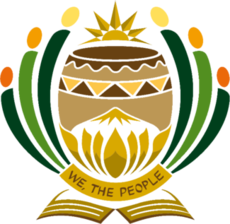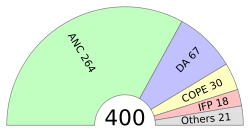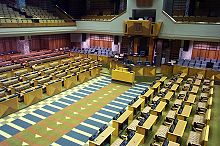- National Assembly of South Africa
-
The National Assembly is the lower house of the Parliament of South Africa, located in Cape Town, Western Cape Province. It consists of no fewer than 350 and no more than 400 members. It is elected every five years using a party-list proportional representation system where half of the members are elected proportionally from 9 provincial lists and the remaining half from national lists so as to restore proportionality.
The National Assembly is presided over by a Speaker, assisted by a Deputy Speaker. The current Speaker is Max Sisulu and the Deputy Speaker is Nomaindia Mfeketo; they were elected on 6 May 2009.[1]
Contents
Allocation
The National Assembly seats are allocated using a proportional representation system with closed lists. Seats are first allocated according to the (integer part of the) Droop quota. Thereafter at most five seats are allocated using the largest remainder method (using the Droop quota). Any additional seats are allocated amongst the parties who then already have seats using the highest averages method.
Voters have one vote at elections to the National Assembly. Seats are allocated in ten multi-member constituencies via party lists. One constituency is a national or 'at large' constituency and nine others represent each of the nine provinces. The lists were called the national lists and regional lists in the 2009 election. 'Regional' was used to avoid confusion with the provincial legislature elections held at the same time. Previously they were called 'National to National' and 'Provincial to National'. Parties decide whether they want to set up both national and provincial lists or only provincial lists. If all parties choose national lists then half of the members will come from the national 'at large' constituency and half from the nine provincial constituencies. If no party chooses a national list then all members will come from the nine provincial constituencies. In the 2009 election one party chose not to use a national list resulting in 168 members being elected from the national constituency and 232 from the nine provincial constituencies.
History
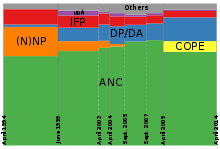 The change over time in the composition of the National Assembly. Solid vertical lines are elections; dashed vertical lines are floor-crossing periods.
The change over time in the composition of the National Assembly. Solid vertical lines are elections; dashed vertical lines are floor-crossing periods.
South Africa 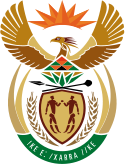
This article is part of the series:
Politics and government of
South Africa- Parliament
- National Council of Provinces
- Chairperson
- National Assembly
- Speaker
- Leader of the Opposition
- Helen Zille (national)
- Lindiwe Mazibuko (parliament)
- National Council of Provinces
- Chief Justice
- Pres. of Supreme Court of Appeal
- Lex Mpati
- Courts
Other- Political parties
- Foreign relations
- Taxation
The National Assembly was first elected in South Africa's first non-racial election in 1994 with the African National Congress (ANC) winning 252 of the 400 seats. The National Party (NP), the previous governing party, won 82 seats, and the Inkatha Freedom Party (IFP) won 43. Under the terms of the Interim Constitution this result entitled the NP and the IFP to take part in the Government of National Unity alongside the ANC, and gave the ANC and NP the right to each nominated one Deputy President. The other parties represented in the assembly were the Freedom Front (9 seats), the Democratic Party (7 seats), the Pan Africanist Congress (5 seats), and the African Christian Democratic Party (2 seats).
In the election of 1999, the ANC won 266 seats, one short of the two-thirds majority needed to unilaterally amend the constitution. The DP expanded its representation to become the official opposition with 38 seats, while the IFP won 34. The NP, now renamed the New National Party (NNP), dropped to 28 seats, and the newly-formed United Democratic Movement (UDM) won 14. Eight smaller parties also obtained seats in the assembly.
In the election of 2004 the ANC obtained 279 seats, gaining a two-thirds majority and the ability to change the constitution. The DP became the Democratic Alliance (DA) and remained the official opposition with 50 seats, while the IFP won 28 seats. The NNP was severely weakened, obtaining only 7 seats; the party was formally disbanded in 2005 with the majority of the party joining the ANC.
In the election 2009 the ANC lost its two-thirds majority but remained the majority party with 264 seats. The DA increased its support to 67 seats, and the new Congress of the People (COPE) party, a breakaway from the ANC, obtained 30 seats. The IFP was reduced to 18 seats.
Election results
The last election was on 22 April 2009.
Summary of the 22 April 2009 National Assembly election results[2] Party Votes % +/− Seats +/− from last
election[note 1]+/− from before
this election[note 2]African National Congress 11,650,748 65.90 −3.80 264 −15 −33 Democratic Alliance 2,945,829 16.66 +4.29 67 +17 +20 Congress of the People[note 3] 1,311,027 7.42 +7.42 30 +30 +30 Inkatha Freedom Party 804,260 4.55 −2.42 18 −10 −5 Independent Democrats 162,915 0.92 −0.81 4 −3 0 United Democratic Movement 149,680 0.85 −1.43 4 −5 −2 Freedom Front Plus 146,796 0.83 −0.06 4 0 0 African Christian Democratic Party 142,658 0.81 −0.80 3 −4 −1 United Christian Democratic Party 66,086 0.37 −0.38 2 −1 −1 Pan Africanist Congress 48,530 0.27 −0.45 1 −2 0 Minority Front 43,474 0.25 −0.11 1 −1 −1 Azanian People's Organisation 38,245 0.22 −0.03 1 0 0 African People's Convention[note 4] 35,867 0.20 +0.20 1 +1 −1 Movement Democratic Party[note 3] 29,747 0.17 +0.17 0 0 0 Al Jama-ah[note 3] 25,947 0.15 +0.15 0 0 0 Christian Democratic Alliance[note 5] 11,638 0.07 −0.13 0 0 −1 National Democratic Convention[note 6] 10,830 0.06 +0.06 0 0 −4 New Vision Party[note 3] 9,296 0.05 +0.05 0 0 0 United Independent Front[note 6] 8,872 0.05 +0.05 0 0 0 Great Kongress of South Africa[note 3] 8,271 0.05 +0.05 0 0 0 South African Democratic Congress[note 3] 6,035 0.03 +0.03 0 0 0 Keep It Straight and Simple 5,440 0.03 −0.01 0 0 0 Pan Africanist Movement[note 3] 5,426 0.03 +0.03 0 0 0 Alliance of Free Democrats[note 6] 5,178 0.03 +0.03 0 0 0 Women Forward[note 3] 5,087 0.03 +0.03 0 0 0 A Party[note 3] 2,847 0.02 +0.02 0 0 0 Total 17,680,729 100.00 400 Spoilt votes 239,237 Notes:
- ^ Change in seats compared to the composition of the legislature after the election of 14 April 2004.
- ^ Change in seats compared to the composition of the legislature after the second floor-crossing period that ended on 15 September 2007.
- ^ a b c d e f g h i Party did not contest the previous election to this legislature.
- ^ Party did not contest the previous election to this legislature, having been created during the floor-crossing period of 2007.
- ^ Successor to the Christian Democratic Party, the Federation of Democrats and the New Labour Party in this legislature.
- ^ a b c Party did not contest the previous election to this legislature, having been created during the floor-crossing period of 2005.
Current composition
Party Seats African National Congress 264 Democratic Alliance 67 Congress of the People 30 Inkatha Freedom Party 18 Freedom Front Plus 4 Independent Democrats 4 United Democratic Movement 4 African Christian Democratic Party 3 United Christian Democratic Party 2 African People's Convention 1 Azanian People's Organisation 1 Minority Front 1 Pan Africanist Congress 1 Total 400 References
- ^ "Sisulu elected National Assembly speaker". Mail & Guardian Online. 6 May 2009. http://www.mg.co.za/article/2009-05-06-sisulu-elected-national-assembly-speaker. Retrieved 6 May 2009.
- ^ "April 22, 2009 General Election Results - Republic of South Africa Totals". Election Resources on the Internet. http://electionresources.org/za/provinces.php?election=2009. Retrieved 24 December 2010.
External links
Parliament of South Africa National Assembly • National Council of ProvincesProvincial legislatures Eastern Cape • Free State • Gauteng • KwaZulu-Natal • Limpopo • Mpumalanga • Northern Cape • North West • Western CapeLocal and metropolitan government Johannesburg • Durban • Cape Town • Pretoria • East Rand • Port ElizabethCurrent members of the National Assembly by party ANC Sisulu - Abram - Ainslie - Balfour - Baloyi - Bapela - Bastardo-Ibanez - R Bhengu - P Bhengu - Bikani - Bloem - Bogopane-Zulu - Bonhomme - Booi - Borman - Boshigo - Botha - Burgess - Carrim - Chabane - Chauke - Chikunga - Chohan - Coleman - Cronin - Dambuza - Davies - De Lange - Diale - Dikgacwi - Dlamini - Dlamini-Zuma - Dlulane - Doidge - Dubazana - Dube - Duma - Dunjwa - Ebrahim - Farisani - Fihla - Fransman - Frolick - Fubbs - Gasebonwe - Gcwabaza - Gelderblom - Gigaba - Gina - Godongwana - Golobo - Gona - Goqwana - Gumede - Gungubele - Gxowa - Hajaig - Hanekom - Hangana - Hendricks - Hogan - Holomisa - Huang - Jeffery - Joemat-Peterson - Johnson - Jordan - Kekana - Kenye - Khorai - Kholwane - Khumalo - Khunou - Komphela - Koornhof - Kota-Fredericks - Kubayi - Landers - Lekgetho - Line - Luthuli - Luyenge - Maake - Mabaso - Mabedla - Mabudafhasi - Mabuza - Madikizela-Mandela - Madlala - Maduna - Mapule Mafolo - Magagula - Magama - Magau - Magazi - Magwanishe - Mahlangu-Nkabinde - Makasi - Makhubela-Mashele - Makhubele - Makwetla - Malale - Malgas - Maluleka - Maluleka - Manamela - Manana - Mandela - Manganye - Mangena - Manuel - Martins - Masango - Mashigo - Mashile - Mashishi - Masilo - Masutha - Mataboge - Mathebe - Mathebe - Mathebula - Mathibela - Matlanyane - Matshoba - Maunye - Mavunda - Mbalula - Mbili - Mdaka - Mdakane - Mdladlana - Mentor - Mfeketo - Mgabadeli - Mjobo - H Mkhize - L Mkhize - Mkhulusi - Mlambo - Mlangeni - Mmusi - Mnisi - Mocumi - Mohale - Molebatsi - Molewa - Moloi-Moroka - Monareng - Morutoa - Moss - Motimele - Motlanthe - M Motshekga - A Motshekga - Motsoaledi - Mpahlwa - E Mthethwa - N Mthethwa - Mtshali - Mufamadi - Mugwanya - Mushwana - Muthambi - Mchabeleng - Ndabandaba - Ndabeni - Ndebele - Nel - Nelson - Nene - Newhoudt-Druchen - Ngcobo - Ngele - Ngwenya - Ngwenya-Mabila - Nhlengethwa - Njikelana - Nkoana-Mashabane - Nkwinti - Nonkonyana - November - C Nqakula - N Nqakula - B Ntuli - Z Ntuli - Nxesi - Nxumalo - Nyama - M Nyanda - S Nyanda - Nyekemba - Nzimande - Oliphant - Oosthuizen - Padayachie - Pandor - Peters - Phaahla - Phaliso - Pillay - Pilusa-Mosoane - Pule - B Radebe - G Radebe - J Radebe - Ramathlodi - Ramodibe - Rantsolase - Rasool - Saal - Schneemann - Sefularo - Segale-Diswai - Selau - Sexwale - Shabangu - Shiceka - Shoba - Sibhida - Sibiya - L Sisulu - Sithole - Smith - Sizani - Skosana - Skweyiya - Snell - Sogoni - Sonjica - Sosibo - Soytu - Stofile - Suka - Sulliman - Surty - Thabethe - Thobejane - Thomson - Tinto - Tlake - Tobias - Tsebe - Tseke - Tsenoli - Tshabalala-Msimang - Tshivhase - Tshwete - Tsotetsi - Turok - Twala - Vadi - van der Merwe - van Schalkwyk - Vanqa - Williams - Xaba - Xasa - Xingwana - Yengeni - B Zulu - L ZuluDA Trollip - Boinamo - Bosman - R Coetzee - T Coetzee - Davidson - De Freitas - Doman - Dreyer - Du Toit - Duncan - Ellis - Farrow - Figlan - Fritz - George - James - Kalyan - Kloppers-Lourens - Kohler Barnard - Kopane - Krumbock - Lamoela - Lee - Lorimer - Lotriet - E Marais - S Marais - Masango - Maynier - Mazibuko - Michael - Mnqasela - Mokgalapa - More - Morgan - Motau - Mubu - Ollis - Pretorius - Rabie - Rabotapi - Robinson - Schäfer - H Schmidt - J Schmidt - Selfe - Shinn - Smiles - Smuts - Steele - A Steyn - B Steyn - Swart - Swathe - Terblanche - van Dalen - van den Berg - van der Linde - van der Walt - van der Westhuizen - van Dyk - van Schalkwyk - Waters - WengerCOPE Lekota - Adams - Balindlela - Blaai - Botha - Carter - Dandala - Dexter - Gcume - George - Kganare - Kilian - Koornhof - MacKenzie - Madisha - Mashiane - Mda - Mnguni - Molao - Ndude - Ngonyama - Nhanha - Njobe - Ntshiqela - Odendaal - Rwexana - Shilowa - Thusi - Tolo - Vukuza-LindaIFP Buthelezi - Cebekhulu - Dhlamini - Lucas - Helen Makhuba - Mncwango - Mpontshane - Christian Msimang - Msweli - Ndlovu - Seeng Ntanzi - Mario Oriani-Ambrosini - Narend Singh - Skosana - Smith - van der Merwe - Zikalala - ZondiFF+ Mulder - Groenewald - C Mulder - SpiesID de Lille - Greyling - Hoosen - SeirusUDM ACDP Meshoe - Dudley - SwartAPC GodiAZAPO MF BhoolaPAC MphahleleUCDP DitsheteloParty leaders in bold Categories:- National lower houses
- Government of South Africa
- Parliament of South Africa
- Parliament
Wikimedia Foundation. 2010.

